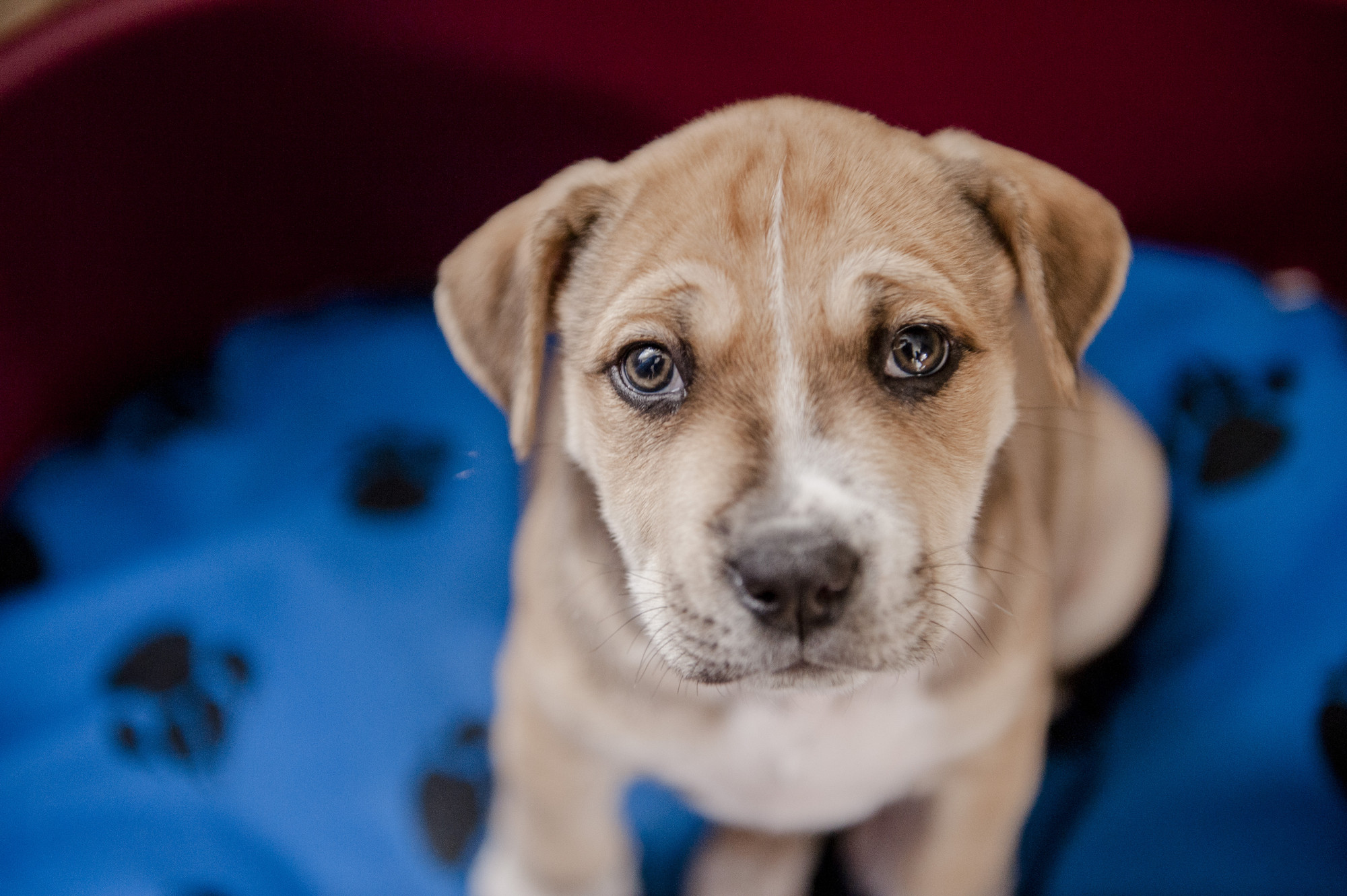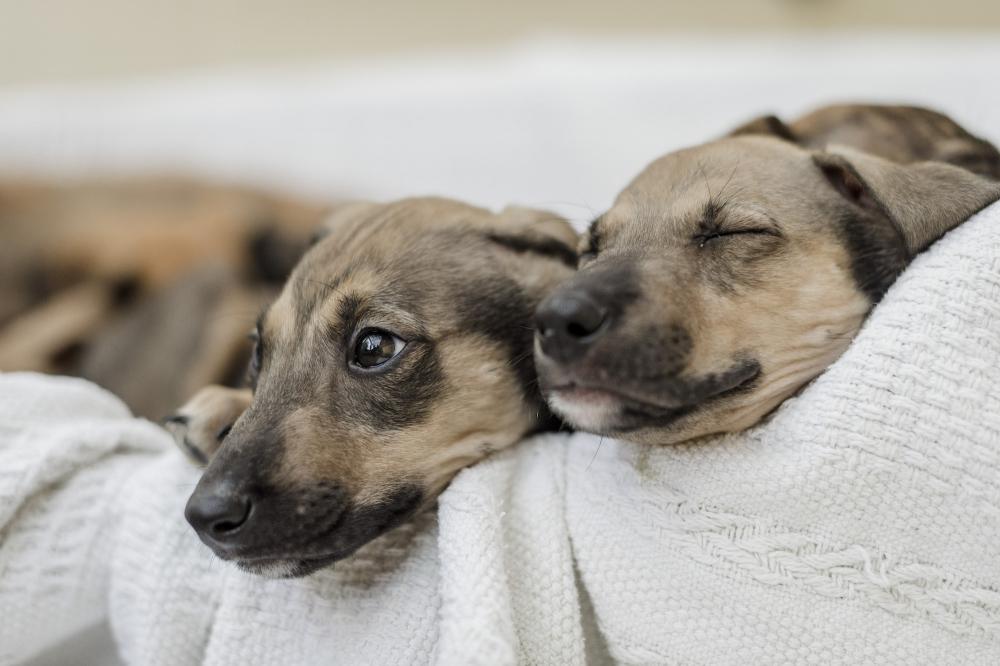
Toilet training a puppy
Once you take your puppy home, you’ll have to begin showing them where you’d like them to toilet – usually this will be your garden or if you don’t have one, an outside area very near to your home.
Unless your puppy has been raised in dirty conditions, house training should be relatively easy, particularly if you stick to a good routine. Dogs naturally want to toilet away from their living area and if your puppy was raised at a Blue Cross centre, the team there will have already started this process giving you a good head start.
How to toilet train your puppy
Start a toilet training routine
When you first wake up, last thing at night and very regularly during the day, take your puppy outside to a place in your garden that you have chosen. If you use newspaper or puppy pads overnight, pop some of the soiled paper in this area as the smell will help your puppy to know where to go to the toilet. Let your puppy walk up and down or run about and sniff the area (both exercise and sniffing help stimulate going to the loo). It’s best to let your puppy out in the garden without a lead on as it will be too restrictive, however if your puppy needs to be on lead for whatever reason, an extendable lead is a good solution as this will give them the freedom they need to toilet.
Avoid playing exciting games in the garden before your puppy has toileted, as this is likely to distract them from the main purpose of going outside. If they want to come back inside straight away, or look confused, patiently walk up and down slowly to encourage them to move about and sniff the ground. Stay outside with your puppy until they have done their business at which point you can give gentle praise. Avoid leaving your puppy outside in the hope that they will eventually go to the toilet, as most puppies will not want to be left alone and will instead concentrate on getting back to you, rather than learning to go to the toilet outside. You might also miss the opportunity to praise your puppy if they do go, or if they don’t go, they may then be ‘caught short’ once back in the house!
If they still haven’t gone to the toilet after five minutes, come back inside the house, but keep a very close eye on them. Repeat this process 10 minutes later (and 10 minutes after that if they still haven’t gone) and hopefully your puppy will eventually toilet in the right place. Set aside lots of time for this and be prepared for several visits to the garden at first. Be patient and your persistence will eventually pay off!
Between trips to the garden, supervise your puppy when in the house. This means keeping your puppy in view at all times and being aware of what they are doing – this is especially important during the first few months. Pay particular attention to the times after your puppy has eaten, woken up or after periods of excitement, such as play.
Signs your puppy needs the loo!
Watch for the typical signs that your puppy needs to go to the toilet – these may include sniffing the floor, circling, looking restless or going into a room they have previously toileted in. Take your puppy immediately to your chosen place in the garden and wait patiently until they have done their business and praise gently.
What to do if your puppy has an accident
Expect your puppy to have several accidents during the first few months of house training. They have very small bladders, and just like young children who are learning to use a potty, they are easily distracted, especially when excited!
It’s important not to punish your puppy if they toilet in the house – this is counterproductive and won’t help them. It will only frighten them and may teach them to avoid toileting in front of you. You may have heard that it is a good idea to rub your puppy’s nose in any mess or take them over to the scene of the crime and tell them off – unfortunately training methods like this are extremely damaging and confusing to a puppy so best avoided entirely!
If your puppy does have an accident when you’re not looking, just clean it up calmly. If you catch your puppy in the middle of going, quietly pick them up and pop them outside to see if they can finish what they started in the right place – if they do, then praise them gently. If they don’t, just be extra vigilant in the house next time.
How to clean after your puppy
It’s important to clean any mess in the house using a warm solution of biological washing powder (for example, a teaspoon of powder dissolved in a cup of warm water) or a specially formulated product from your vet. This type of product will clean the area properly. Avoid using ammonia based products such as bleach as this is likely to cause your puppy to use the same area again.
Toilet training when your puppy is by themselves
Toilet training when you are out of the house
During the initial stages of house training it’s best not to leave your puppy alone - ideally you should wait until house training is well established. If you do have to go out, then leave them in the area that they are most comfortable (see Home alone) making sure your puppy has had the chance to exercise and go to the toilet beforehand. Leave out some paper for your puppy to toilet on (away from their bed area) should they need to go - although this won’t teach your puppy where you would like them to go to the toilet, it will make any mess easier to clean up and stops the area becoming soiled.
Toilet training a puppy at night
Most puppies don’t have strong enough bladders to be able to hold on overnight for several months, so unless you have your puppy upstairs with you, expect to come downstairs to a bit of mess. Lay down newspaper away from their bed area until your puppy can hold on for longer. Remember to take them out first thing to give them an opportunity to relieve themselves as soon as possible.
How long does it take to toilet train a puppy?
You’ll need to continue with this routine for several months, although some puppies may need extra time and help. During this process, your puppy learns about getting praise for going to the toilet outside and, since you’ll be supervising them in the house, they won’t get an opportunity to go inside. Throughout the first few months and for a while afterwards, continue to go out with your puppy to the garden in order to praise them until they know exactly what to do.
After a few months of the above routine, and as your puppy gets older - gradually increase the time between visits to the garden. When your puppy has the urge to go, they will probably become more active or may wander over to the door. Watch for a change in their behaviour and take them out quickly. Gradually, as you start to recognise the signs that mean your puppy needs to go, you can relax your supervision in the house. Some puppies may need reminding regularly, so make sure you give them plenty of opportunity to relieve themselves outside.
Keep at it!
Although house training a puppy can be hard work and tiring - be patient and consistent, and all your efforts should pay off!
If you need help at all with house training your puppy, please contact the centre you rehomed your pet from and we will do our best to help you.





